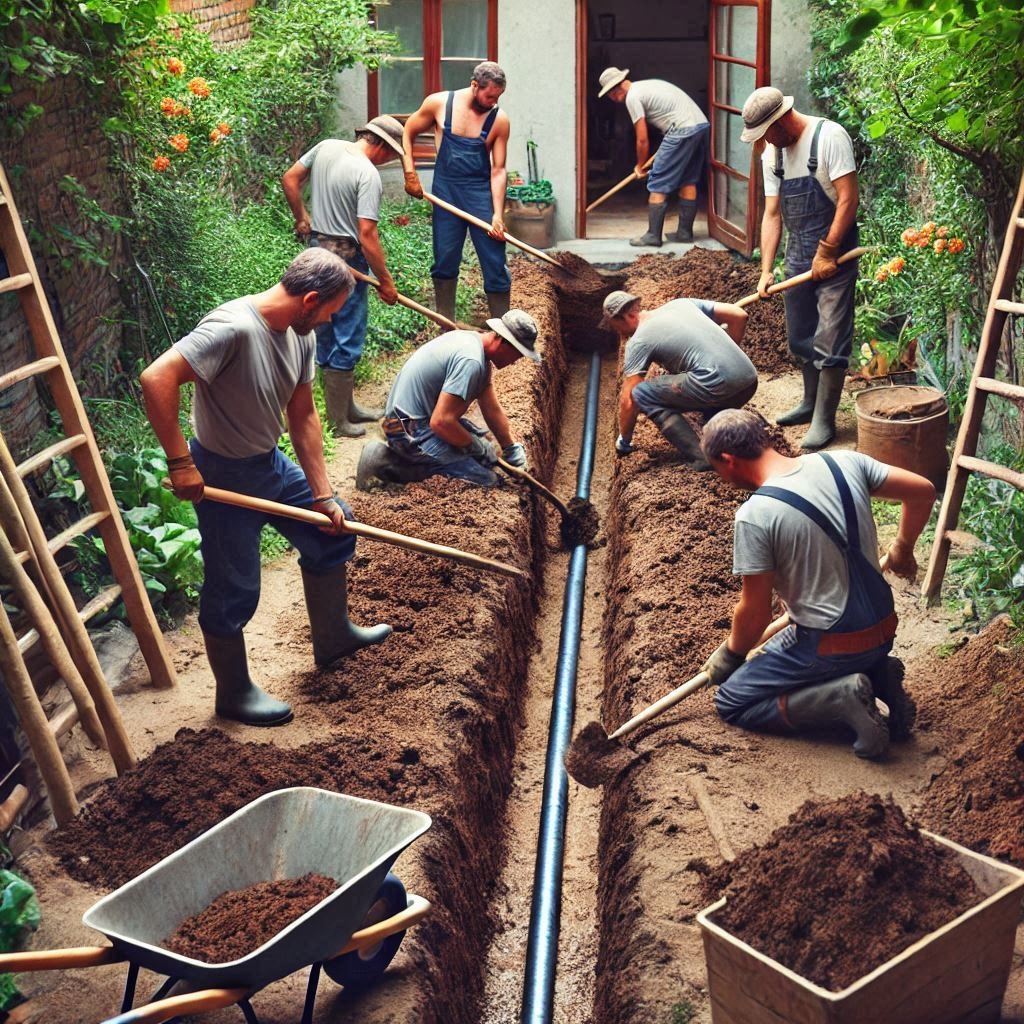How Deep Should Your Water Line Be Buried? The Essential Guide
While laying down a water line for any residential or commercial structure, it is basic to comprehend the proper depth at which it should be buried.
Getting this right dodges different issues, from freezing pipes in the winter to expected damage from surface exercises. Water lines are fundamental for the protected and dependable conveyance of water, so guaranteeing they’re all around safeguarded underground becomes imperative.

Deciding the ideal depth is generally impacted by climate, local codes, and, surprisingly, the soil type, with each variable adding to the choice on how profound the line should go.
Water lines should be installed at a depth that will safeguard them from freezing in colder climates or from unsettling influences nearer to the surface, like landscaping or construction.
The depth requirements shift essentially contingent upon location, with colder climates for the most part requiring more noteworthy depths than warmer regions. To assist with understanding these varieties and how they apply to your property, here are a few significant contemplations.
Discover more: How Deep to Bury Water Line | 1 Call Solve Problem
Standard Depth Requirements
The principal thought for the depth of a water line is local climate. In locales that experience freezing temperatures, pipes should be buried below what is known as the ice line — the depth at which groundwater in the soil freezes throughout the winter.
In the event that a pipe is buried excessively near the surface, it risks freezing and causing pipe bursts, which can be both costly and testing to fix. By and large, in regions with serious winters, this can mean covering water lines four to five feet down, albeit this depth can differ in light of explicit local conditions.
For instance, in pieces of the United States like the Midwest and Northeast, the ice line can be just about as profound as four to five feet, requiring water lines to be buried at comparative depths. Conversely, in warmer southern states where ice is to a lesser extent a worry, pipes may just should be buried 12 to 24 inches down.
In states like Florida and Texas, where freezing temperatures are exceptional, the depth requirements are more adaptable, yet even in these warmer climates, it’s fundamental to follow local codes to guarantee pipes stay protected from any expected dangers or startling weather.
At times, civil codes direct the specific depth to keep pipes from being installed in a manner that could prompt future issues. Regularly, these codes consider climate as well as territorial soil attributes. For example, sandy or free soil may not protect pipes as really as compacted dirt, possibly requiring a more profound installation even in regions without unforgiving winters.
Sticking to these standards guarantees that the water line isn’t just safeguarded yet in addition open for future upkeep or fixes, as shallow or excessively profound installations can muddle work later on.
Also, one of the benefits of sticking to suggested depths is keeping accidental damage from normal family exercises. At the point when water lines are buried excessively near the surface, they become more helpless to damage from digging, landscaping, or construction projects. For example, a shallow pipe could without much of a stretch be struck by a digging tool during routine planting, prompting expensive fixes and water disturbances. By adhering to local guidelines, land owners can keep away from such accidents and the bother that goes with them.
Changing Depth for Soil Type and Environmental Conditions
Another basic variable while deciding the depth of a water line is the type of soil on the property. Soil properties can fluctuate fundamentally starting with one locale then onto the next, and even starting with one piece of a property then onto the next.
Soil type impacts not just the solidness of the ground encompassing the water line yet in addition its protecting properties. For instance, earth and loamy soils by and large give more steady conditions to buried pipes and help safeguard against temperature vacillations, as they hold warmth and dampness better than sandy soils. In regions with rockier or more permeable soil types, there may be a requirement for additional safeguards.
In rough regions, it very well might be important to dig further to keep away from obstruction with stones and debris that could damage the pipe after some time. On the other hand, rough soils might require encasing the pipe in a defensive layer, like sand or gravel, before refilling.
This adds a support zone that retains shock and protects the pipe. The extra depth likewise maintains a strategic distance from contact with sharp shakes that could wear out or penetrate the pipe over the long run.
Sandy soil, conversely, channels water more rapidly and can disintegrate quicker than other soil types. Here, water lines are some of the time buried marginally more profound or given extra protection to forestall temperature changes from arriving at the pipe.
At the point when water depletes excessively fast through sandy soil, it doesn’t hold the temperature of the ground also, which could open pipes to temperature limits in certain climates. In regions inclined to heavy rains, sandy soil can likewise move all the more effectively, making it fundamental to introduce water lines in a steady way that records for the potential for disintegration.
Environmental conditions are another thought, particularly in the event that the water line requirements to go through regions with successive human activity or heavy equipment use, like driveways or pathways.
On the off chance that a water line should cross under a carport or walkway, it should be buried further than in regions without heavy burden bearing surfaces. The heaviness of vehicles or consistent people walking through can overburden a pipe, so covering it more profound offers added insurance.
This additional depth likewise safeguards against potential dangers brought about by freezing temperatures, which can fuel issues in vigorously dealt regions where the ground is more compacted. At the point when a pipe is buried at a sufficient depth under these types of surfaces, the risk of accidental damage from over the ground exercises is limited. This additional safeguard guarantees a safer water line installation that can endure everyday tensions and any unexpected weather examples.
Significance of Consulting Local Regulations and Professionals
While wanting to cover a water line, consulting local regulations and perhaps captivating a professional plumber or worker for hire is profoundly prudent.
Local construction laws are created with a profound comprehension of the territorial climate, soil, and environmental elements that influence water lines. These codes may likewise incorporate explicit suggestions for materials and installation rehearses that can upgrade the toughness and security of buried pipes in your space.
Professional plumbers have the experience and knowledge to evaluate environmental and administrative contemplations in a manner that can improve the installation for both life span and usefulness.
They can recognize any possible difficulties on a property that probably won’t be immediately self-evident, for example, the presence of high groundwater, varieties in soil type, or the potential for soil development.
In regions with high water tables, for example, a plumber could suggest waterproof materials or other specific installation strategies to forestall water penetration or strain development around the pipe.
One more critical benefit of consulting with professionals is that they know about any new innovations or materials that could expand the existence of the installation.
Present day materials like cross-linked polyethylene (PEX) or other strong piping options offer more prominent adaptability and protection from pressure, settling on them a decent decision for water lines.

Plumbers and workers for hire are many times acquainted with these materials and may propose their utilization in regions where sturdiness or temperature obstruction is a worry. By utilizing their aptitude, land owners can arrive at informed conclusions about their installation that will forestall issues long into the future.
As well as offering direction on materials, professionals can help with any extra defensive estimates that may be beneficial. For instance, in very cool regions, they could suggest adding protection around the pipe or introducing heat tape for extra ice security.
In tremor inclined regions, they might utilize adaptable fittings to assimilate possible changes in the ground. These safeguard measures are particularly significant for regions subject to outrageous environmental stressors, as they can enormously diminish the probability of disappointment and expand the life expectancy of the water line.
A professional installation likewise guarantees that the water line can be overhauled or fixed effortlessly from now on. By introducing pipes as per best practices and local codes, professionals make it simpler for future fixes to be directed securely and effectively. Now and again, they might try and incorporate passages that consider simpler support or investigations, which can decrease expenses and downtime assuming any issues emerge.
At long last, consulting local regulations and employing professionals assists with staying away from lawful issues that could emerge from ill-advised installations. Resistant water lines can prompt fines, legitimate difficulties, and perhaps a prerequisite to re-try the work.
By following local codes all along, land owners can have confidence that their water line installation will satisfy the guidelines set by their city or district, guaranteeing both consistence and inner serenity.
All in all, covering a water line requires smart thought of climate, soil type, and environmental conditions. By understanding these elements and consulting professionals, land owners can guarantee that their water line is installed at the legitimate depth for security, solidness, and life span.

